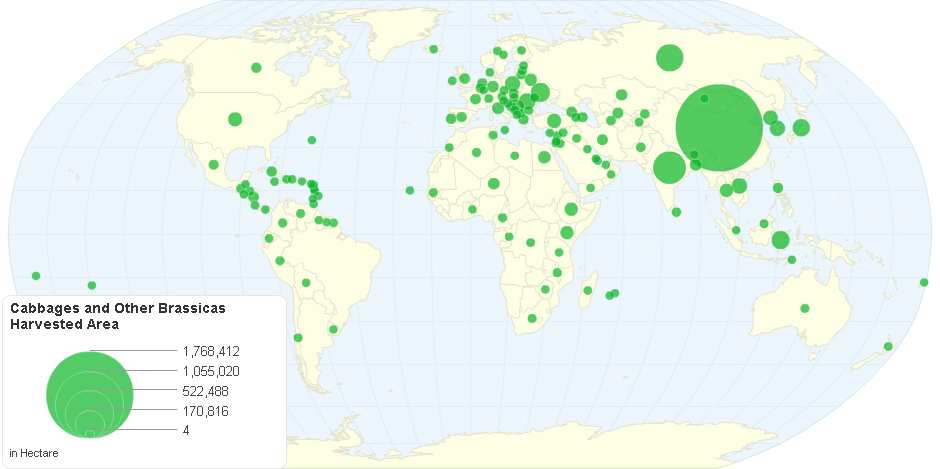This chart shows Cabbages and other brassicas Harvested Area by Country.
Cabbage or headed cabbage is a leafy green or purple biennial plant, grown as an annual vegetable crop for its dense-leaved heads. It is descended from the wild cabbage, B. oleracea var. oleracea, and is closely related to broccoli and cauliflower, brussels sprouts and savoy cabbage. Cabbage heads generally range from 0.5 to 4 kilograms and can be green, purple and white.
Smooth-leafed firm-headed green cabbages are the most common, with smooth-leafed red and crinkle-leafed savoy cabbages of both colors seen more rarely. It is a multi-layered vegetable. Under conditions of long sunlit days such as are found at high northern latitudes in summer, cabbages can grow much larger. Some records are discussed at the end of the history section.
Almost half of these crops were grown in China, where Chinese cabbage is the most popular Brassica vegetable. Cabbages are prepared in many different ways for eating. They can be pickled, fermented for dishes such as sauerkraut, steamed, stewed, sautéed, braised, or eaten raw. Cabbage is a good source of vitamin K, vitamin C and dietary fiber. Contaminated cabbage has been linked to cases of food-borne illness in humans.
Brassica is a genus of plants in the mustard family, the . The members of the genus are informally known as cruciferous vegetables, cabbages, or mustard plants. Crops from this genus are sometimes called cole crops—derived from the Latin caulis, denoting the stem or stalk of a plant.
The genus Brassica is known for its important agricultural and horticultural crops and includes a number of weeds, both of wild taxa and escapees from cultivation. Brassica species and varieties commonly used for food include broccoli, cabbage, choy sum, rutabaga, turnip and some seeds used in the production of canola oil and the condiment mustard. Over 30 wild species and hybrids are in cultivation, plus numerous cultivars and hybrids of cultivated origin.
Brassica plants have been the subject of much scientific interest for their agricultural importance. Six particular species evolved by the combining of chromosomes from three earlier species, as described by the Triangle of U theory.
9 years ago

